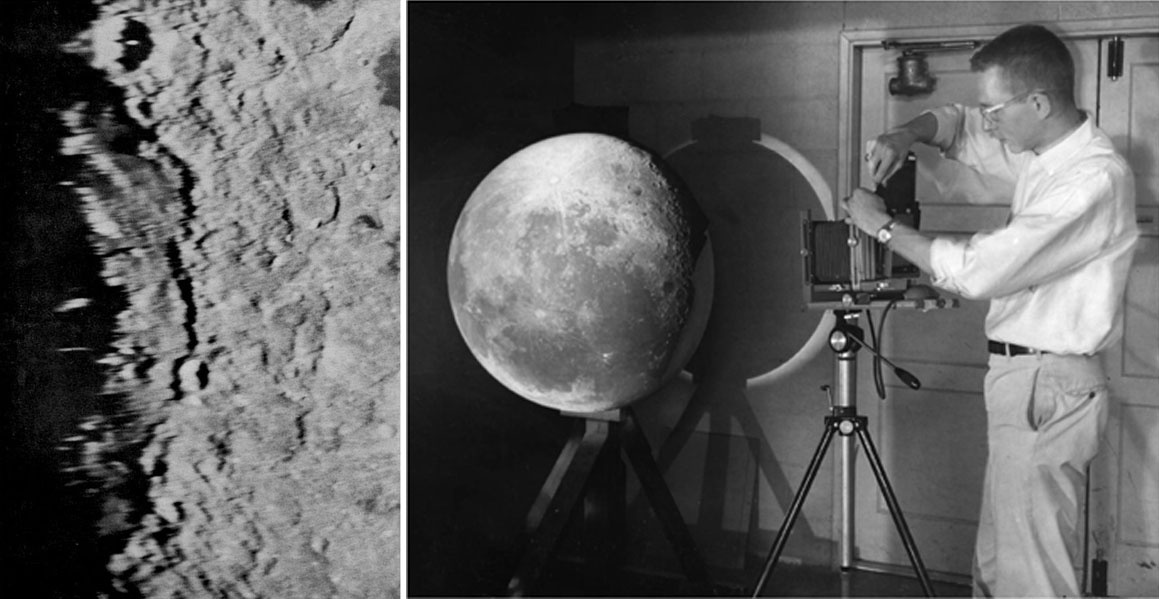Difference between revisions of "April 12, 2011"
| (7 intermediate revisions by the same user not shown) | |||
| Line 1: | Line 1: | ||
__NOTOC__ | __NOTOC__ | ||
=50 Years Ago= | =50 Years Ago= | ||
| − | + | <!-- Start of content --> | |
| − | + | <!-- ws:start:WikiTextHeadingRule:0:<h1> --> | |
| − | + | <!-- ws:start:WikiTextLocalImageRule:6:<img src="/file/view/LPOD-Apr12-11.jpg/219318574/LPOD-Apr12-11.jpg" alt="" title="" /> -->[[File:LPOD-Apr12-11.jpg|LPOD-Apr12-11.jpg]]<!-- ws:end:WikiTextLocalImageRule:6 --><br /> | |
<em>images from [http://www.psi.edu/epo/multiring_impact_basins/multiring_impact_basins.html Planetary Science Institute], Tucson, AZ</em><br /> | <em>images from [http://www.psi.edu/epo/multiring_impact_basins/multiring_impact_basins.html Planetary Science Institute], Tucson, AZ</em><br /> | ||
<br /> | <br /> | ||
| − | For four hundred years of lunar observation the biggest features on the Moon were unknown. Although there was some [ | + | For four hundred years of lunar observation the biggest features on the Moon were unknown. Although there was some [[October_1,_2004|prehistory]] of recognition, the modern understanding of impact basins began in 1961 when grad student Bill Hartmann re-photographed telescopic images of the Moon projected on a large white globe. This allowed limb regions to be seen as if from overhead, revealing concentric rings around the small mare patch of Orientale. Hartmann analyzed similar overhead images of other circular maria on the nearside, discovering consistent patterns of rings around what he called multi-ring basins. Bill wrote the discovery paper with his mentor, Gerard Kuiper, and then two more papers on radial lineations (Imbrium sculpture}, and finally in 1971 a paper on the ages of basins on the near and the far sides. You can now trace the development of understanding of basins by reading these classic papers [http://www.psi.edu/epo/multiring_impact_basins/multiring_impact_basins.html online], along with Bill's personal reflections on the work. <br /> |
<br /> | <br /> | ||
<em>[mailto:tychocrater@yahoo.com Chuck Wood]</em><br /> | <em>[mailto:tychocrater@yahoo.com Chuck Wood]</em><br /> | ||
<br /> | <br /> | ||
<strong>Related Links</strong><br /> | <strong>Related Links</strong><br /> | ||
| − | Rükl plate [ | + | Rükl plate [https://the-moon.us/wiki/R%C3%BCkl_50 50]<br /> |
<br /> | <br /> | ||
<strong>HISTORICAL NOTE</strong> Today is the [http://www.esa.int/esaCP/SEM5A57S9MG_index_0.html 50th anniversary] of Yuri Gagarin's flight into space. The early 60s were a heady time to be doing space science research!<br /> | <strong>HISTORICAL NOTE</strong> Today is the [http://www.esa.int/esaCP/SEM5A57S9MG_index_0.html 50th anniversary] of Yuri Gagarin's flight into space. The early 60s were a heady time to be doing space science research!<br /> | ||
<br /> | <br /> | ||
| + | <p><b>Yesterday's LPOD:</b> [[April 11, 2011|Inspired To Go Ot]] </p> | ||
| + | <p><b>Tomorrow's LPOD:</b> [[April 13, 2011|Refined Ages]] </p> | ||
<hr /> | <hr /> | ||
| − | + | {{wiki/ArticleFooter}} | |
| − | |||
| − | |||
| − | |||
Latest revision as of 18:42, 13 October 2018
50 Years Ago

images from Planetary Science Institute, Tucson, AZ
For four hundred years of lunar observation the biggest features on the Moon were unknown. Although there was some prehistory of recognition, the modern understanding of impact basins began in 1961 when grad student Bill Hartmann re-photographed telescopic images of the Moon projected on a large white globe. This allowed limb regions to be seen as if from overhead, revealing concentric rings around the small mare patch of Orientale. Hartmann analyzed similar overhead images of other circular maria on the nearside, discovering consistent patterns of rings around what he called multi-ring basins. Bill wrote the discovery paper with his mentor, Gerard Kuiper, and then two more papers on radial lineations (Imbrium sculpture}, and finally in 1971 a paper on the ages of basins on the near and the far sides. You can now trace the development of understanding of basins by reading these classic papers online, along with Bill's personal reflections on the work.
Chuck Wood
Related Links
Rükl plate 50
HISTORICAL NOTE Today is the 50th anniversary of Yuri Gagarin's flight into space. The early 60s were a heady time to be doing space science research!
Yesterday's LPOD: Inspired To Go Ot
Tomorrow's LPOD: Refined Ages
COMMENTS?
Register, Log in, and join in the comments.



